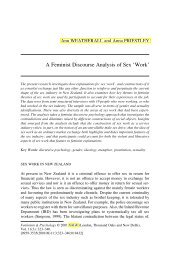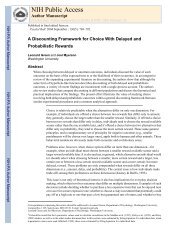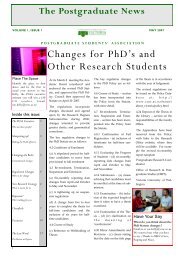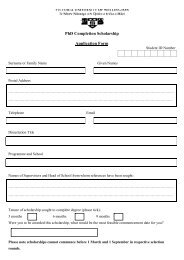Page 242242 <strong>Perner</strong>gave this tendency its stamp of approval. Again, there is no intrinsic reason torefrain from cognitive analysis of the innards of modules, but the focus is onthe module doing its job regardless of its complicated internal workings.Moreover, modularity provided a useful launch pad for neurocognition andfunctional brain imaging as it provided theoretical reasons for there to belocalizable brain regions responsible for particular knowledge domains. Alsothe clinical drive for developing tests of differential potential in specific knowledgedomains did not help cognitive explicitness. Like intelligence tests, suchtests help differentiate people’s level of ability but do not illuminate the cognitiveunderpinnings of intellectual functioning. In sum, all this had theironic consequence that the heirs of the cognitive revolution became in someof their extreme forms more anti-cognitivist than behaviorism ever was (atleast the structure of the learned material shed some light on the cognitivestructure).My concern here is the particular knowledge domain of folk psychology ortheory of mind. It, too, is increasingly and exclusively treated as anunanalysed ability. My plea in this chapter is to return to a more explicitcognitive analysis to help shed light on the intransigent dispute betweenboosters’ mentalist interpretations (Tomasello & Call, 2006) and scoffers’ 2“behavior-rule” (Povinelli & Vonk, 2004) interpretations of nonhuman animals’social competence. And similarly, help is required for explaining humaninfants’ precocious “implicit” understanding of the mind (false beliefs;Onishi & Baillargeon, 2005) in view of their known problems until later inchildhood on direct, “explicit” tests of false belief (Clements & <strong>Perner</strong>, 1994).NOT FOR DISTRIBUTIONPovinelli’s challenge: Mentalism or “behavior rules”Do chimpanzees, who are excellent gaze-followers and have intricate understandingof where someone else is looking, also understand that lookingleads to knowledge, which then influences the knower’s behavior? After manynegative results under strict experimental control (Povinelli & Eddy, 1996)using cooperative set-ups, more positive evidence emerged finally from foodcompetitionsituations (Hare, Call, Agnetta, & Tomasello, 2000; Hare &Tomasello, 2001). Subordinate individuals observe carefully the dominant’slooking behavior when food is being placed. Registration of the dominant’svisual access influences the likelihood of the subordinate’s dashing for thebait, expressing appreciation of the fact that the dominant is less likely toclaim the bait if he has not been able to see it being placed than when he didsee the baiting. Povinelli and Vonk (2003, 2004) claimed that the subordinate’sfeat does not establish understanding of the dominant’s mind (knowledgestate) mediating between his looking and going for the bait. Rather, itcan be understood on the basis of “behavior rules” that capture the regularityof how the dominant’s visual access influences his likely behavior, withouthaving to understand that there is a mental state of knowledge mediatingbetween visual access and behavior.Perception, attention, and action:International Perspectives on Psychological Science (Volume1). Peter A. Frensch and Ralf Schwarzer (Eds). 2010.Published by Psychology Press on behalf of the International Union of Psychological Science.This proof is for the use of the author only. Any substantial or systematic reproduction,re-distribution, re-selling, loan or sub-licensing, systematic supply or distribution in anyform to anyone is expressly forbidden.15:58:17:03:10Page 242
Page 243Anti-cognitivism infiltrates theory of mind 243This controversy is marked by much discussion of what possible behaviorrules there could be to account for the range of available data. One argument(Tomasello & Call, 2006) was that the scoffers, who denigrate the animal’sabilities, have to assume so many more different explanations than theboosters, who grant the animal mental insight: “the boosters clearly haveparsimony on their side. The number of different explanations requiredto explain the evidence is sensibly smaller (12 versus 1 for 12 items of evidence)”(p. 380). This conclusion is a good demonstration of the current anticognitivismof the mentalist boosters. They treat mentalism as a singleexplanation, in contrast to the myriad of behavior rule explanations requiredto cover the evidence. This is to overlook that a cognitive analysis of theanimals’ mentalism also requires a myriad of rules – in fact, for this particularcase, as many plus one as there are behavior rules required.Without going into details of the nature of the required behavior rules, Ifocus on the general observation by Povinelli and Vonk (2004):NOT FOR DISTRIBUTION. . . the subject’s predictions about the other agent’s future behaviorcould be made either on the basis of a single step from knowledge aboutthe contingent relationships between the relevant invariant features ofthe agent and the agent’s subsequent behavior, or on the basis of multiplesteps from the invariant features, to the mental state, to the predictedbehavior. (pp. 8–9)This general observation then issues into my Recipe for posing Povinelli’schallenge:Let the Mentalist give you a specification of the inference proceduresrequired to get from what the animal observes to the ensuing mental stateand from that state to the predicted behavior. Collapse these inference rulesinto one that allows inference of the predicted behavior directly from whatthe animal observes.So, in case of food competition, a Mentalist has to specify for the subordinatechimp something like the following two computational inference procedures(CIPs), where “S” stands for the observable situation including the dominant’slooking behavior, “m” for an unobservable, to-be-inferred mental state(knows about food), “A” for the to-be-predicted action (e.g., goes for bait),and “→” for the respective CIPs on which these (subconscious) inferences arebased:S → m:“IF a dominant D looks at (has visual access to) a bait Bbeing placed at location L,THEN P knows 3 that B is at L.”Perception, attention, and action:International Perspectives on Psychological Science (Volume1). Peter A. Frensch and Ralf Schwarzer (Eds). 2010.Published by Psychology Press on behalf of the International Union of Psychological Science.This proof is for the use of the author only. Any substantial or systematic reproduction,re-distribution, re-selling, loan or sub-licensing, systematic supply or distribution in anyform to anyone is expressly forbidden.15:58:17:03:10Page 243






